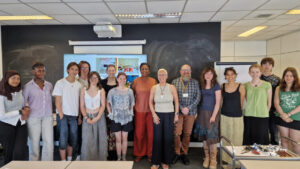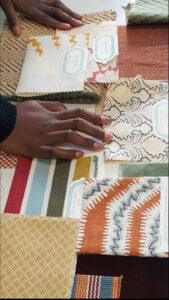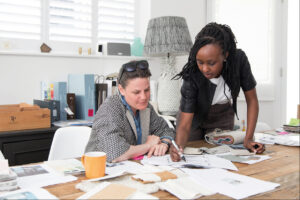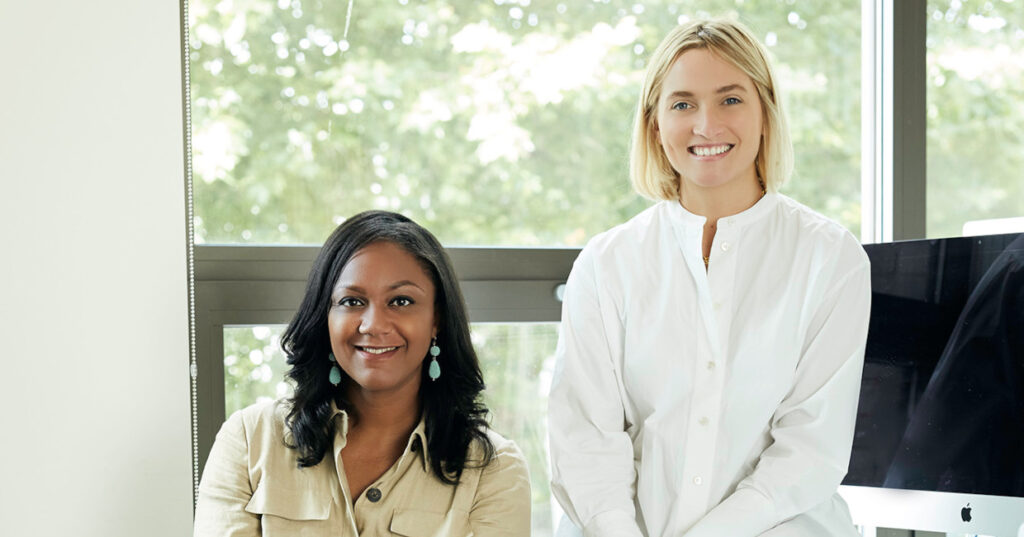Having witnessed major disparity in the design industry when it came to seeing talent from ethnic minorities, Alexandria Dauley and Sophie Ashby decided to take action. In conversation with Sophie Harper, Alexandria Dauley told her how United in Design is making a difference to the world of design–one apprentice at a time.
Interior designer and founder of Dauley Design, Alexandria (Alex) Dauley was introduced to Sophie Ashby, founder of Studio Ashby, following ‘Blackout Tuesday’ in 2020 and the posting of black squares on social media accounts by millions of people in solidarity to protest racism and police brutality following George Floyd’s death. “Everybody put their little black squares on Instagram and lots of people in our industry did that, but I personally felt that you should be held accountable then – if you care and you’re displaying that you care about this issue then what is it you’re actually doing about it?”
Alex felt there was something that could be done to tackle the lack of diversity within the design industry. “I often found myself being the only person of colour in any room with regards to industry events. When I studied at KLC School of Design I was the only black student and when I’ve subsequently gone back to teach, there are still very few black or brown students, so I felt action was needed.”
Sophie felt the same way and through a mutual friend, they were introduced to each other. “I’d sort of just reached out to people who had their black squares and I think Sophie did similarly. So, we had a conversation and put our heads together to work out how we could, as members of the industry, do something, trying to work out what we could create.”
Alex’s daughter had gone through an access programme for the Royal Ballet School, which gave Alex some inspiration. “Chance to Dance is a programme where they go into inner-London schools to offer ballet to students who wouldn’t have considered that artform as something for them. She won a place at the Royal Ballet School because of that. I’d also had a mentor myself when I left KLC, so I realised mentoring was a really powerful tool to help people.”

Together, Alex and Sophie drew up seven pledges to build a mentorship programme around. “We wanted to keep it simple to encourage people to get involved, because simplicity is key in all of these things – we didn’t want people to feel overwhelmed with what we were asking them to do.”
Looking at the hiring process of most design studios, they realised there was an issue with everyone going to the same places for graduates. “That’s when we came up with the apprenticeship programme. “To be honest we weren’t sure how they would manifest but we knew we needed to do something and when we looked around there wasn’t anyone else doing this. We didn’t really think we’d start a charity; we thought maybe there was something that already existed but there wasn’t so we thought if there’s nobody else it may as well be us!”
United in Design (UiD) was formed and things snowballed as support rolled in with a number of businesses wanting to sign-up. “It was such a hot topic. I think the vast majority of people felt as though they needed to do something to address it. It can be a tricky topic to discuss, I think people feel uncomfortable talking about it because they’re worried about offending others or saying the wrong thing, so we very much approached it from the perspective that this is an educational offering, you can talk to us and we will try to guide you as best as we can. We’re all learning the best way in which to change the industry, we’re trying to change the way people see, think, address, and that’s not going to happen overnight. This is very much a journey we can all take together and we can learn together and so I think because we took that approach, we weren’t finger-pointing or blaming – people just didn’t know what they didn’t know – they’ve done things a certain way forever and a day and they’ve hired from the same place always because it’s super easy, we’re asking people to make a change and we needed to make that as easy as possible for people to get involved with.”

Alex and Sophie did a lot of research before setting up the charity and found that even though there weren’t huge numbers of people of colour studying design, there were some, but they weren’t then going on to find jobs in the industry following graduation. “To get a job in a firm you have to have a minimum of a year’s worth of experience, even for the most junior role, and so if they weren’t able to get an internship or any work at all a lot of them were then leaving the industry. It was a case of trying to plug that gap between graduation and getting that first job, which is where the idea for the apprenticeship scheme came from – we could give them and provide them with that crucial year and then they can move into the industry from there.”
Clare Cowburn Baker, United in Design’s Charity Director, who joined Alex during the interview explained that they work with a company called Interior Educators – another charity and an umbrella organisation for many of the main universities across the UK that run either interior architecture or interior design courses. “We’ve made promotional videos in the past that go out to all the course tutors to outline the criteria for apprentice application, which is flagged up to graduates in the third year of their degree to send us a portfolio and covering letter explaining why they want to be part of the apprenticeship programme.”

She goes on to explain that potential apprentices go through the system and are then interviewed. “We put businesses that are hosting apprentices into groups of four and the apprentices are interviewed by all four companies,” she says.
Each apprenticeship lasts a year with graduates spending three months at each placement before moving to the next. “It’s a fully-paid apprenticeship of £22,000 a year,” says Clare. “It gives them a really amazing kick-start into the top-tier companies in central London, which if you’re at college in Stoke on Trent or Hull, you might not otherwise get the opportunity to move to London knowing you’ve got money coming in. We help with guarantor letters on rental properties, we give a lot of support, the whole point is that they won’t be landing in London cold, trying to get a job.”
Throughout the year, the United in Design team keep in close contact with apprentices and host studios to make sure everything is going smoothly. “We check in during the first few weeks, then halfway through, then three quarters of the way through and then they move onto the next company and it starts all over again,” says Clare. “By the time they get to their fourth placement we’ve become a bit ‘extra’ as they already know what they’re doing and most of them have a job offer or two from the companies they’ve been on placement with.”
Alex explains that it’s not just beneficial for the apprentices, but that studios benefit greatly from having more diverse young designers working with them. “The businesses are being exposed to different types of talent, new talent. They’re not your identikit, conveyor belt of design student or graduate, these are people that are coming with different technical skills, different life backgrounds and they are really able to enhance the workplace.”
United in Design might be just at the beginning of its journey, but Alex has ambitions and is hopeful for the future. “We’re called United in Design because we genuinely want to unite the industry. I don’t want there to be any segregation – like here’s a black designers network and then there’s something separate for others. It’s about bringing the industry together. In an ideal world this conversation wouldn’t even need to be happening, everyone should be hired completely on the merit of their skills – the best person for the job should get the job irrespective of their background.

“Should there be more help in the interim for underrepresented groups – yes there should be. But the hope is that we’ll get to a stage where it won’t be necessary. I’m just a designer, I’m black, but I’m a designer and I just want to be judged on my work. Nobody wants to be a token, nobody wants to be that tick box exercise, everybody wants to feel they can stand shoulder to shoulder with their peers because they deserve to be there and that’s what I want for all our apprentices, for them to earn their stripes on their placements, spend a few years working, earning, networking, growing, and then have their names above the door, I want them to be the ones doing the hiring because then you will see a difference, then you’ll see a real difference when those people are the ones running their own businesses.”



